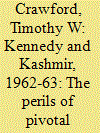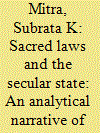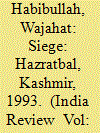| Srl | Item |
| 1 |
ID:
022621


|
|
|
|
|
| Publication |
2002.
|
| Description |
1-38
|
| Summary/Abstract |
This article examines the Kennedy administration's strategy for making peace between India and Pakistan in 1963. It was assumed that India and Pakistan's mutual need for US support would lead them to curry US favor by showing flexibility on Kashmir. However, the US vied with the USSR as a patron to India, and with China as an ally to Pakistan. As a hedge against weak US promises to defend Pakistan against Indian attack, Pakistan cultivated a tacit alliance with China, while for India, Moscow became an enthusiastic alternative source of military supplies. This forced the United States to reduce the political conditions it attached to its military patronage and diplomatic support, which helps to explain why the US effort to broker peace in Kashmir failed in 1963. It also suggests important obstacles to the United States doing so today.
|
|
|
|
|
|
|
|
|
|
|
|
|
|
|
|
| 2 |
ID:
022622


|
|
|
|
|
| Publication |
2002.
|
| Description |
39-72
|
| Summary/Abstract |
In the mid-1950s, the Indian government eagerly embraced a leading role in international efforts to make peace in Indochina. Within a decade, however, India had lost much of its enthusiasm for the task and nearly all of its credibility as a mediator. This article asks why India deteriorated as a peacemaker between 1962 and 1967, years when other nations stepped up their efforts, albeit with little ultimate success, to mediate the Vietnam conflict. It argues that Indian diplomacy in Southeast Asia was limited by deep-seated problems that increasingly beset the country in its second decade of independence: Tensions with China and Pakistan constrained India's ability to hold an independent course in Southeast Asia. Meanwhile, mounting political turmoil within India interfered with consistency in Indian foreign policy. Finally, reliance on foreign assistance rendered India vulnerable to pressure to modify its position on the war
|
|
|
|
|
|
|
|
|
|
|
|
|
|
|
|
| 3 |
ID:
022624


|
|
|
|
|
| Publication |
July 2002.
|
| Description |
99-130
|
| Summary/Abstract |
The continuing controversy over India's personal laws even after five decades of Independence is seen by many as indicative of its incomplete modernity and limited secularization. This article challenges such views in terms of two main arguments. First, it asserts that the debate on whether India should have one uniform civil law or many personal laws has made it possible for interests of different communities to be articulated and galvanized into positions. The second main argument of this article is to show, on the basis of an exegesis the cultural roots and historical path of the evolution of colonial legislation, the broad range of resources available in India for the institutionalization of a personal law regime. The convergence of positions both in the high politics of the state and the everyday politics of society points towards the plurality of personal laws as an optimal solution for orderly and democratic state-society relations in India.
|
|
|
|
|
|
|
|
|
|
|
|
|
|
|
|
| 4 |
ID:
022623


|
|
|
|
|
| Publication |
July 2002.
|
| Description |
73-98
|
| Summary/Abstract |
This article discusses the Indian Army's siege of Kashmir's premier religious shrine in 1993. The article explores the army's laying of a siege to flush out Kashmiri militants in the Hazratbal shrine; it examines events that influenced the trajectory of negotiations; and it outlines key lessons learned from the peaceful resolution of the siege. It shows how such confrontations between security forces and militants are influenced by third parties such as the local population and mediators. And it highlights the value of co-opting the local population, and of ensuring that the public, who is often the target audience for the militants, urges settlement, not confrontation.
|
|
|
|
|
|
|
|
|
|
|
|
|
|
|
|